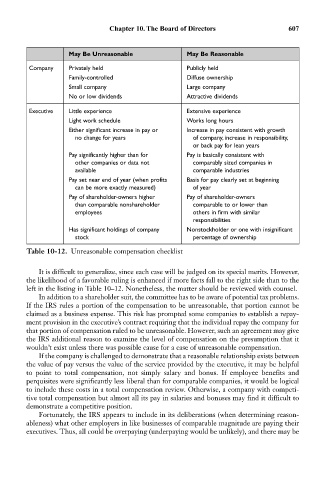Page 622 - Bruce Ellig - The Complete Guide to Executive Compensation (2007)
P. 622
Chapter 10. The Board of Directors 607
May Be Unreasonable May Be Reasonable
Company Privately held Publicly held
Family-controlled Diffuse ownership
Small company Large company
No or low dividends Attractive dividends
Executive Little experience Extensive experience
Light work schedule Works long hours
Either significant increase in pay or Increase in pay consistent with growth
no change for years of company, increase in responsibility,
or back pay for lean years
Pay significantly higher than for Pay is basically consistent with
other companies or data not comparably sized companies in
available comparable industries
Pay set near end of year (when profits Basis for pay clearly set at beginning
can be more exactly measured) of year
Pay of shareholder-owners higher Pay of shareholder-owners
than comparable nonshareholder comparable to or lower than
employees others in firm with similar
responsibilities
Has significant holdings of company Nonstockholder or one with insignificant
stock percentage of ownership
Table 10-12. Unreasonable compensation checklist
It is difficult to generalize, since each case will be judged on its special merits. However,
the likelihood of a favorable ruling is enhanced if more facts fall to the right side than to the
left in the listing in Table 10–12. Nonetheless, the matter should be reviewed with counsel.
In addition to a shareholder suit, the committee has to be aware of potential tax problems.
If the IRS rules a portion of the compensation to be unreasonable, that portion cannot be
claimed as a business expense. This risk has prompted some companies to establish a repay-
ment provision in the executive’s contract requiring that the individual repay the company for
that portion of compensation ruled to be unreasonable. However, such an agreement may give
the IRS additional reason to examine the level of compensation on the presumption that it
wouldn’t exist unless there was possible cause for a case of unreasonable compensation.
If the company is challenged to demonstrate that a reasonable relationship exists between
the value of pay versus the value of the service provided by the executive, it may be helpful
to point to total compensation, not simply salary and bonus. If employee benefits and
perquisites were significantly less liberal than for comparable companies, it would be logical
to include these costs in a total compensation review. Otherwise, a company with competi-
tive total compensation but almost all its pay in salaries and bonuses may find it difficult to
demonstrate a competitive position.
Fortunately, the IRS appears to include in its deliberations (when determining reason-
ableness) what other employers in like businesses of comparable magnitude are paying their
executives. Thus, all could be overpaying (underpaying would be unlikely), and there may be

